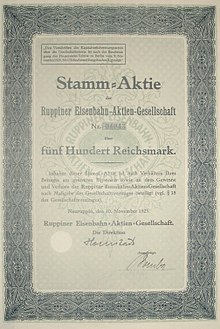Ruppin Railway
The Ruppiner Eisenbahn Aktien-Gesellschaft ( RE ) was a private German railway company based in Neuruppin . At that time it operated one of the largest private rail networks in Brandenburg .
history
The company was created on March 15, 1913 through the merger of the Kremmen-Neuruppin-Wittstocker Eisenbahn-Gesellschaft (KWE) with the Ruppiner Kreisbahn Eisenbahn-Aktien-Gesellschaft (RK). The seat of the company was the district town of Neuruppin .
The KWE was founded on April 29, 1896 and opened its 65-kilometer main line Kremmen –Neuruppin– Wittstock (Dosse) on February 1, 1899; Freight traffic had already started on December 16, 1898. The extension via Freyenstein to Meyenburg (27 km) only came about on February 1 and April 14, 1912.
The RK brought its 43-kilometer route from Neustadt an der Dosse via Neuruppin to Herzberg , which opened on November 1, 1902 and was operated by the KWE.
The now 135 kilometers of railway lines - 7.5 kilometers of which at Netzeband and Rossow in the Grand Duchy of Mecklenburg-Schwerin - with the Neuruppin junction expanded further after the First World War through the acquisition of the Löwenberg-Lindow-Rheinsberger Eisenbahn-Gesellschaft (LLR) in 1921. Their 37 km long route led from August 11, 1896 from Löwenberg to Lindow and on May 18, 1899 to Rheinsberg . It was licensed as a small railway until 1906 .
When the line of the Paulinenaue-Neuruppiner Eisenbahn-Gesellschaft (PNE) opened on September 12, 1880 with a length of 30 kilometers was added, the Ruppiner Eisenbahn-Gesellschaft owned a standard gauge network of over 200 kilometers. This had a connection to the state railway at five points , above all to the main routes Berlin – Hamburg and Berlin – Neustrelitz . It was extended on May 15, 1928 by the 13-kilometer section Rheinsberg - Zechlin Flecken .
In addition, since August 8, 1930, RE has been running the newly opened Kleinbahn-AG Gransee-Neuglobsow , which owned the 33-kilometer-long Stechlinseebahn. This also had a connection from Schulzendorf to Lindow.
Between 1930 and 1945, RE operated a coherent branch line network stretching around 250 kilometers, as well as three bus routes over 50 kilometers in length. At that time it was one of the largest private railway companies in the German Reich and had its railcars run on Reichsbahn tracks as far as Berlin.
At the end of the Second World War , the majority of the shares were in the hands of the Province of Brandenburg and several municipalities , especially the Ruppin and Ostprignitz districts and the cities of Neuruppin and Wittstock. Nevertheless, RE was unable to maintain its independence. After a transition period as a state railway company, it came to the Deutsche Reichsbahn in 1949 . Except for the Rheinsberg – Zechlin Flecken line, the rail network of the former Ruppiner Eisenbahn AG was spared dismantling .
The Wittstock – Meyenburg line was shut down and dismantled on May 28, 1967. Passenger traffic from Neuruppin to Paulinenaue also ended on May 20, 1970; freight traffic followed after reunification in 1995. On the other hand, the Deutsche Reichsbahn built a line from Rheinsberg to the nuclear power plant ; today this belongs to the Energiewerken Nord GmbH.
On the other hand, by order of the occupying forces, the entire Gransee – Neuglobsow railway network was dismantled for reparation purposes as early as 1945 . A few years later, military reasons led to the reconstruction of the Gransee - Großwoltersdorf section . From 1952 to June 1, 1969, passenger traffic took place here again. Since then there has been freight traffic to Wolfsruh. In 2006 the tracks were dismantled again.
Holdings
RE became an investor in the civil servant housing association Neuruppin eGmbH, today's non-profit housing cooperative Neuruppin eG
Web links
- Ruppiner Kreisbahn on berliner-bahnen.de
- Ruppiner Eisenbahn for contributions to the history of locomotives and railways
- Ruppiner Eisenbahn on commemorative publication of the non-profit housing cooperative Neuruppin eG
- Early documents and newspaper articles on the Ruppin Railway in the 20th Century press kit of the ZBW - Leibniz Information Center for Economics .
